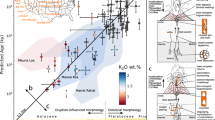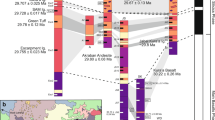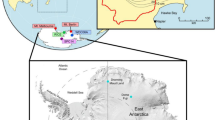Abstract
THE Serra Geral Formation consists of lava flows and is associated with dolerite dykes. It covers an area of about one million square kilometres in Uruguay and southern Brazil and is one of the largest volcanic masses in the world. From stratigraphic evidence its age could lie in the range from Upper Triassic to Upper Cretaceous; quite possibly it may be uppermost Triassic (Rhaetic) to Jurassic in age1.
This is a preview of subscription content, access via your institution
Access options
Subscribe to this journal
Receive 51 print issues and online access
$199.00 per year
only $3.90 per issue
Buy this article
- Purchase on SpringerLink
- Instant access to full article PDF
Prices may be subject to local taxes which are calculated during checkout
Similar content being viewed by others
References
Leinz, V., Contribuicao a geologia dos derrames basalticos do sul do Brazil, Boletim CIII, Geologia No. 5 (Univ. São Paulo, 1949).
Creer, K. M., Geophys. J., 7, 1 (1962).
The Phanerozoic Time-Scale; A Symposium, 1964, Quart. J. Geol. Soc., 120 S. (1964).
Amaral, G., Cordiani, U., Kawashita, K., and Reynolds, J. H., Geochim. Cosmochim. Acta (in the press).
McDougall, I., J. Geophys. Res., 68, 1535 (1963).
McDougall, I., Nature, 190, 1184 (1961).
Author information
Authors and Affiliations
Rights and permissions
About this article
Cite this article
CREER, K., MILLER, J. & SMITH, A. Radiometric Age of the Serra Geral Formation. Nature 207, 282–283 (1965). https://doi.org/10.1038/207282a0
Issue date:
DOI: https://doi.org/10.1038/207282a0
This article is cited by
-
The genesis of the amethyst geodes at Artigas (Uruguay) and the paleohydrology of the Guaraní aquifer: structural, geochemical, oxygen, carbon, strontium isotope and fluid inclusion study
International Journal of Earth Sciences (2010)
-
Paleomagnetism, rock-magnetism and geochemical aspects of early Cretaceous basalts of the Paraná Magmatic Province, Misiones, Argentina
Earth, Planets and Space (2006)
-
Middle Cretaceous sediments from the eastern part of Walvis Ridge
Nature (1974)
-
Flood traps through space and time and their bearing on some problems of geotectonics
Bulletin Volcanologique (1971)
-
Die Paläogeographie der expandierenden Erde vom Karbon bis zum Tertiär nach paläomagnetischen Messungen
Geologische Rundschau (1966)



